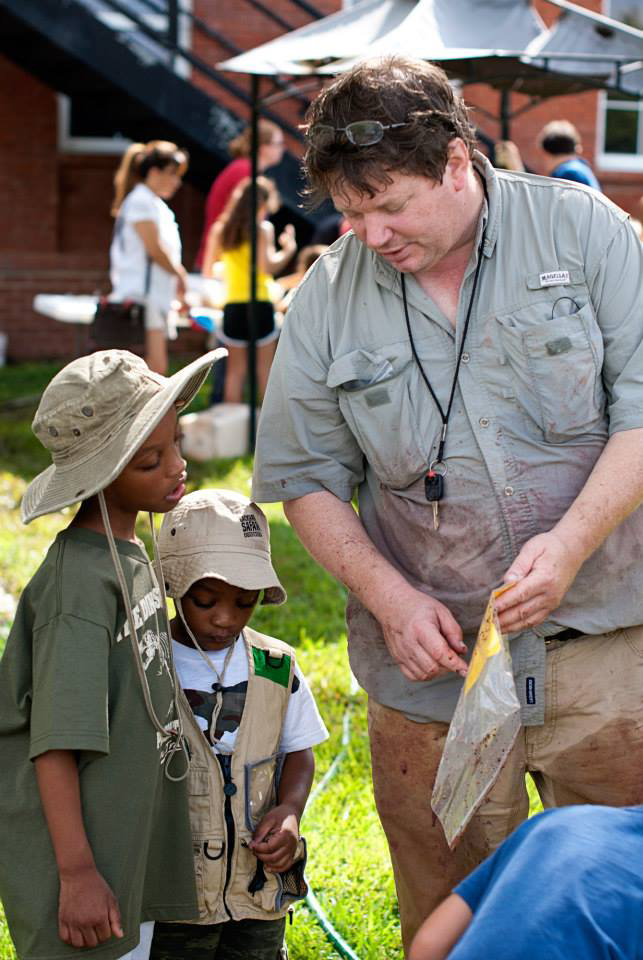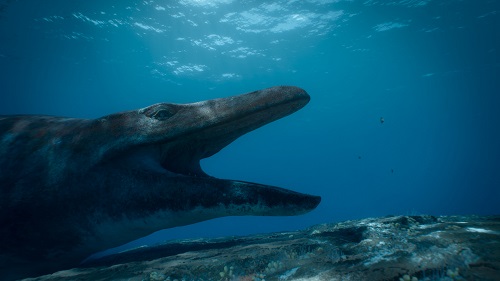If you want to be a paleontologist, you’ve got to get your hands dirty… and sometimes wet.
Now you can learn just what it takes to get down to the nitty-gritty of separating fossils from soil and get a little messy yourself! Just come to the Houston Museum of Natural Science at Sugar Land for Fossil Wash Day this Saturday from 9 a.m. to noon. You’ll be able to help our staff and other volunteers spray down samples dug from our very own exclusive fossil site near Seymour, Texas, the home of the famous fin-backed prehistoric reptile Dimetrodon. While you’re washing, you can chat with our experts about your favorite dinosaurs. Who knows? You may be the first to lay hands on a bone that hasn’t seen the sunlight in hundreds of millions of years.

Fossil Wash Day is a community gathering perfect for dinosaur fans and families interested in real science.
Fossil Wash Day is a four-year tradition at HMNS Sugar Land, the perfect location for splashing around and playing with mud. The “big back yard” has a nearby water source and is perfect for the process. Large clumps of Baylor County clay will be placed in five-gallon buckets of water with a bit of hydrogen peroxide to help deflocculate, or break up, the sample. Then the clay will be taken from the buckets of water and plopped onto a screen which will catch small fossil fragments.

Searching for fossils is a job for both children and adults, and is a big help to our museum paleontologists.
“We’re looking for the things we missed. The things we didn’t know were there,” said David Temple, Associate Curator of Paleontology, who usually hosts the event. A scheduled visit to a fossil site in Germany will prevent him from joining the fun.

HMNS Associate Curator of Paleontology David Temple teaches two children how to bag fossils at Fossil Wash Day. While Temple usually appears at the event, he will be out of the country this year.
“Once we run the samples through the screens, we empty the screens out and find bits of bone and things, and we catalog the bits,” Temple said. “It’s citizen science. A way for the public to get involved. It’s a chance to do real science and you’ll never know what you’ll find. And you do find things.”

At Fossil Wash Day, small bones such as this phalange discovered by a volunteer help the Houston Museum of Natural Science collect data about Permian-era reptiles and amphibians.
Most finds from these samples contain fossilized teeth from prehistoric sharks, Dimetrodon and others. Fossils discovered at the event go into our collection, where they are valued for the information they share about the distant past. From teeth, depending on the details on the fossil, paleontologists can tell how Permian-era creatures fed and fought with one another. Broken Dimetrodon teeth, for example, show that the animal chewed its food instead of swallowing it whole.
“If you’ve got shed teeth, you can tell something fed there, even if you don’t find bones there,” Temple said. “As opposed to finding a socketed tooth where the carcass has rotted. Sometimes we find crushed bone. From these fossils, we learn what they’re chewing on and how the teeth wear.”

The clay matrix from Seymour, Texas is transported in clumps back to Houston. In the clumps, you never know what you’ll find.
If you’ve got fossils at home, bring those along, too, and have them identified. With the paleontologists and volunteers working alongside the public, it’s a great opportunity to spark up a one-on-one Q&A. There will be more volunteers inside the museum preparing Eocene-era fossils from another dig site near Bryan-College Station. Plus, you’ll get a look at other specimens in our fossil touch carts.
“Fossil Wash Day is a super hands-on kind of thing. You get filthy,” Temple said. “Wear something you don’t mind getting wet.”








